- Life top
- Daily Life
- Applying for LINE stickers
- Exhibition of Matsumoto-sensei
- Hana - Shiba-Inu
- Elec. handicraft & Akihabara
- Supermarkets in the area
- Takaido Civic Center
- Building a house
- Horrible dentists
- Judo therapy
- In an elderly care home
- Parties
- Cosplay bonenkai 2010
- Gainax cosplay bonenkai
- Friends from Gainax
- Friends from schooldays
- Party at Bar Espion
- Home party with cheese
- Music Life
- TARO Quartet
- Maeda-san - violin maker
- Chigusa Kindergarten
- Seniors playing music
- My viola debut
- Torakyo regular concert
- Toranomon Orchestra
- Four seasons
- Shrine visit of the New Year
- New Year´s postcard
- Snowfall in Tokyo
- Hina-matsuri and hina-dolls
- Sakura - cherry-blossom
- Sakura - what I missed most
- Fireworks Festival
- People
- Itakura - his adventurous life
- Naoto - his country life
Sakura - cherry-blossom
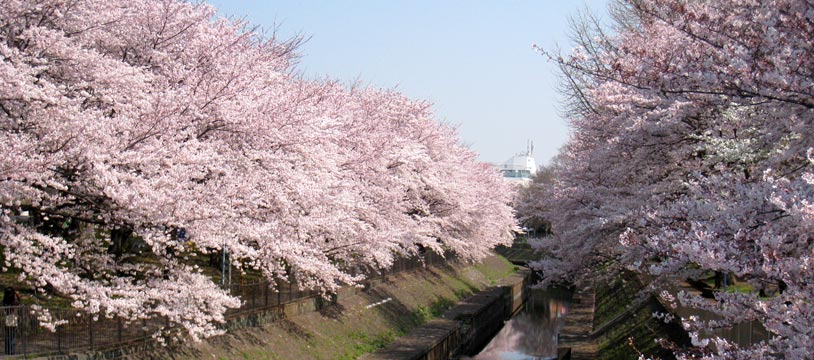
Zenpukuji-gawa Park is a popular place for cherry-blossom viewing.
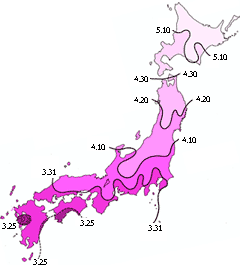
Sakura front of the last 10 years' average by the Meteorologial Agency
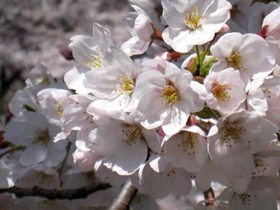
Somei-yoshino has gorgeous flowers and a very short full bloom period.
The cherry-blossom is the national flower of Japan. It is a long lasting tradition in Japan to organize a party under cherry-blossom and appreciate them. In order to find the ideal timing for cherry-blossom viewing, we often check the announcement of the Meteorological Agency on cherry blossoming and plan our party. When the season approaches, the Agency frequently reports on the "Sakura front" or "cherry-blossom front", which is a terminology to express the front line of cherry blossom flowering. The sakura front goes up the Japanese archipelago from the south to the north in a month or so. Due to global warming and heat-island phenomena the sakura front moves up earlier year after year.
The cherry-blossom has not simply been flowers to enjoy their beauty, but something which symbolizes supernatural power and death.
Saigyo (1118-1190), a priest and a renowned poet, wrote innumerable number of poems on cherry-blossoms. Among them, the most famous poem is the following;
- I wish to die in spring
under cherry-blossoms
in the time of full moon of February
- (*)
- Saigyo wrote poems in "waka" style, the most popular style of traditional poems, which should be made in 31 syllables in the sequence of 5-7-5-7-7. Here is the original text of the quoted poem;
Ne-ga-wa-ku-wa
Ha-na-no mo-to-ni-te
Ha-ru shi-nan
So-no ki-sa-ra-gi-no
Mo-chi-zu-ki-no ko-ro
The month "February" is not a mistranslation. It is expressed in lunar calendar.
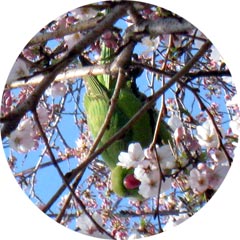
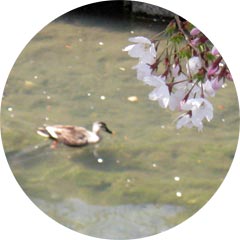
Various kinds of birds are also enjoying cherry-blossom. Wild ducks are the most popular birds in the water beneath the cherry trees. It is however surprising to see parrots eating cherry flowers (photo above) in a group of four or five. This seems to be another result of the warming.
"Under the cherry-blossom in full bloom" describes the story of a bandit in medieval time. At the end of a cruel story, the bandit carries his awfully beautiful wife on his back and passes under the full blooming cherry-blossom. He suddenly becomes spine-chilling and realizes that the one on his back is not a woman but a demon and frantically strangled the demon. After everything is over he finds his beautiful wife lying dead under cherry petals. He cries. He tries to remove petals from her face and finds there nothing other than cherry petals. His body also disappears and there remain only cherry petals and a chilly empty space.
Another writer Kajii Motojiro (1901-1932) wrote a short and poem-like prose "Under cherry trees" and said that cadavers were buried under cherry trees with the blossom in full bloom. Kajii cannot stand the beauty of full blooming cherry-blossom and tries to keep balance by coupling the beauty with a negative image such as death.
However, for many people the image of cherry-blossom can more easily associated with death, because they fall swiftly as if they have no attachment to this world. I presume that this image was created by a particular species of cherry trees "Somei-yoshino". Somei-yoshino is a hybrid cherry species and was created in the mid 19th century. Somei-yoshino has quickly spread over Japan and become the representative spices of the Japanese cherry-blossom, because it has particularly intense cluster of flowers. They look gorgeous in their full blooming and the full bloom does not last long. Usually it lasts only a few days and the whole blossom falls in a following few days. The falling of blossom is more appreciated than the full bloom, because it shows us the fragility of our life and the beauty of a manly death.
Therefore, sakura became a symbol of soldiers and sailors during the Imperial Japan. The most popular Japanese military song "Douki no sakura" compares two class mates to two cherry trees in the campus of a military aviation school and expresses their resolution to fall like cherry-blossom. I understand that the pilots of suicide corps needed to beautify their death, which they otherwise could not accept. (Check the bottom part of "Japanese popular songs from the 19th century till 1945". )
However, this linkage between military spirit and cherry-blossom seems to have become old-fashioned by now. Nowadays, most people associate cherry-blossom to the change of school- or business-years. As the public life starts in April 1 in Japan, freshmen start their new life in their school or company under cherry-blossom. It is also the season of farewell to old friends and colleagues and of welcome to new ones. Therefore many human dramas develop in this time.
Just before the cherry-blossom season, Japanese high-schools and universities hold entrance examinations. Whether cherry-blossom blooms or falls is an indirect expression of passing or failing an entrance examination. The same expression is used for employment tests and if somebody has luck, he can get an notification saying "cherry-blossom blooms".
Thus, the cherry-blossom is linked to the events in our life and takes a special place in everybody's memory.
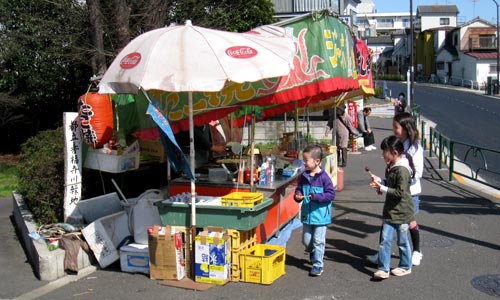
Stalls for small titbits are necessary institutions for cherry-blossom viewing.
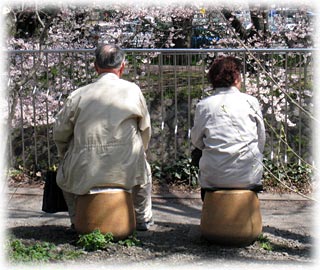
Little away from the bustle of children, an old couple is quietly viewing cherry blossom.
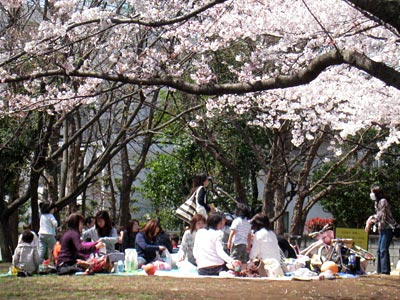
On a weekday afternoon, mothers with small children dominate the cherry blossom viewing scene.